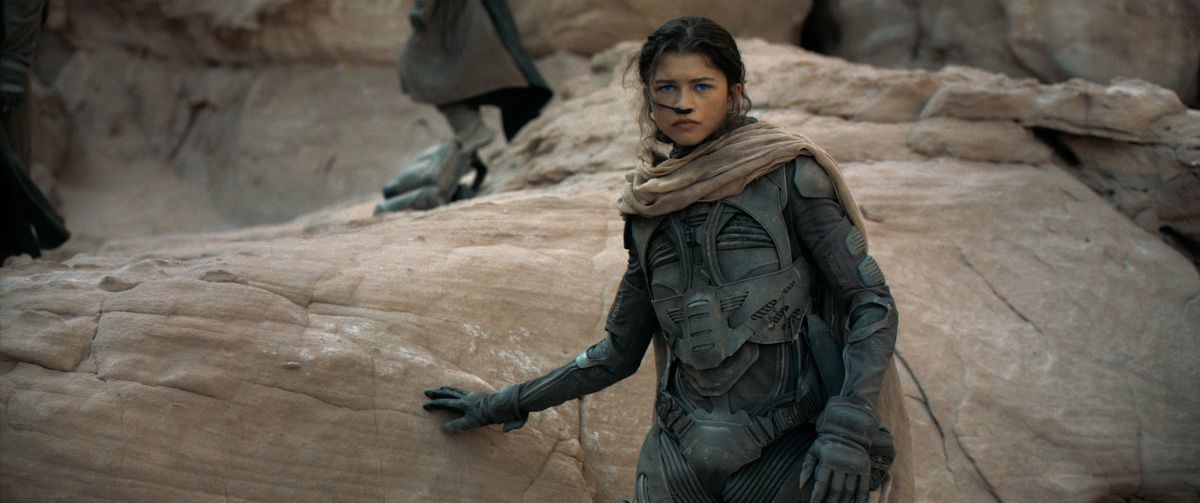Denis Villeneuve’s planned trilogy of Dune movies is unmistakably focused on telling the story of Paul Atreides, as played by Timothée Chalamet. But just because it’s Paul’s story doesn’t mean he’s the main character of all of the movies. In fact, one of the cleverest, most effective methods Villeneuve uses to show us Paul’s journey in Dune: Part Two is by subtly shifting the Freman warrior Chani (Zendaya) from her initial role as narrator and love interest into the movie’s main character. And Zendaya is one of the few actors who could actually pull that off.
[Ed. note: This story contains spoilers for Dune: Part Two.]
At the beginning of Dune: Part Two, Paul’s mother, Lady Jessica (Rebecca Ferguson), is slowly consolidating power, trying to convince both the Fremen and Paul himself that he is the prophesied messiah, Lisan al Gaib. That prophecy was planted by Jessica’s Bene Gesserit organization many generations ago as a means of controlling the Fremen. At first, Paul is resolute in refusing to back Jessica in manipulating the Fremen, who saved Paul and Jessica’s lives after the Harkonnen family attacked them and drove them into the desert. Paul doesn’t want to be the Fremen’s messiah, he wants to be their equal.
But as the movie progresses, Paul’s desire for revenge against the Harkonnens grows, and the idea of surviving without taking control of the Fremen on Arrakis begins to look less and less possible to him. By the time he decides to go south and meet with the Fremen fundamentalists, it’s clear that Paul has chosen to accept the role of the Lisan al Gaib, something he knows will bring about the death of billions of people across the universe. His Fremen lover Chani wants to steer him away from that future, and she can’t.
Image: Warner Bros.
Communicating his shift from main character and hero to something far darker and more complicated is one of Dune: Part Two’s greatest challenges. It would probably have been impossible for the movie to fully make Paul a villain. It wouldn’t have been authentic to the narrative or its themes for his story to end that cleanly anyway. But Villeneuve’s much cleverer solution is to show us Paul’s slow but steady drift toward the lures of power.
Dune: Part Two lets us see that transformation through Chani’s eyes. From the moment Paul first rides a sandworm, Villeneuve starts showing us Chani’s reactions rather than Paul’s when people speak. Where the camera used to hang on Chalamet’s face after he delivered a particularly stirring speech to the Fremen, it instead cuts to Zendaya, reacting with mounting fear that she may have lost the person she loves to the weight of manipulated prophecy.
By the time Paul drinks the Water of Life and Chani is forced to revive him, Paul has practically become a supporting character. Scenes start and end with her involvement. Even Paul’s climactic ascendancy to Emperor is cut short by Chani leaving. And when she does, she’s the character we follow, as she heads into the desert and rides off into the sunset, closing out the movie.
It’s a delicate change, and a subtle enough shift in the narrative that most people might not even notice if they aren’t actively looking for it. But its effect is strong enough to carry the movie’s thematic core: We know Paul is a changed man, and that he’s taken a turn for the worse, because we can clearly see those thoughts forming on the face of the person he loves. The filmmaking and writing is a huge part of why this shift works so well and is able to communicate so much. The script, written by Villeneuve and Jon Spaihts, constantly frames Chani as a skeptic about the prophecy, but never lets that interfere with her love for Paul.
But the other, even more important, reason all of this works so well is Zendaya’s performance. Zendaya is, plain and simple, an absolute movie star.

Photo: Warner Bros.
She’s tremendously charismatic, funny, and winning on screen, and she’s able to garner sympathy from the audience in Dune: Part Two through pure charm and loving glances alone. It’s economical performance at its best. She takes a supporting role that could easily get lost in the epic swells of Dune’s space opera and turns it into the single most important thing in the movie. It’s the best Zendaya has ever been on the big screen.
Her performance feels like a coronation, but not a surprise. Zendaya has been a celebrity for years now, moving from a Disney Channel child star to a social media darling. It’s been almost five years since she first got the chance to show off her acting chops on HBO’s angsty teen drama Euphoria.
But she’s never gotten to star in a major movie before. Sure, she’s a supporting player as MJ in the Sony/MCU collaborative Spider-Man movies, but those belong to the Marvel Cinematic Universe more than they belong to any particular star, and she’s still usually third-billed at best, behind Tom Holland and a villain or two. She had a featured role in The Greatest Showman that gave her screen time but no depth, and a title role in Netflix’s Malcolm & Marie that gave her depth but minimal impact. And she’ll get a chance to genuinely lead a movie later this year in the excellent-looking Challengers.
But for now, Dune: Part Two is the biggest blockbuster role she’s had yet. And it’s hard to think of any other actor her age who could have pulled this off. At 27, she has the built-in charisma that only a star can bring to the role. The audience is rooting for her in Dune: Part Two even before it officially becomes her movie, because they walked into the theater knowing they already love her. That’s something only a star can give a movie.

